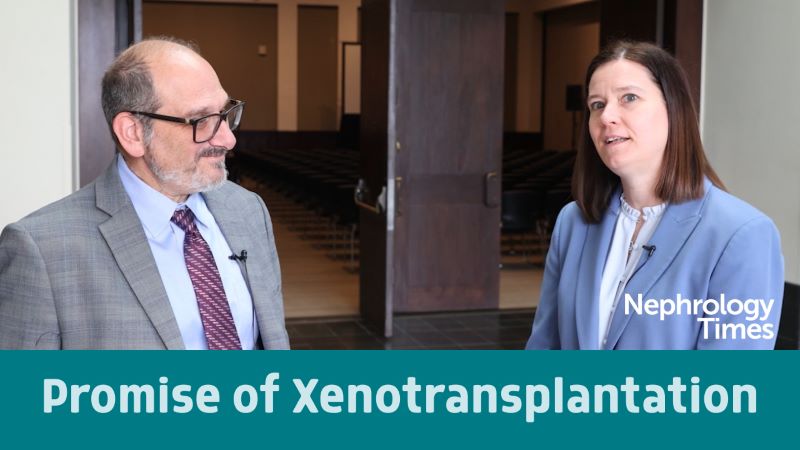
Among patients diagnosed with complement 3 glomerulopathy (C3G) and primary immune complex membranoproliferative glomerulonephritis (IC-MPGN), median time to kidney failure is approximately 10 years from diagnosis. Kidney transplant recipients with kidney failure related to those diseases face a high rate of disease recurrence after transplant of up to 80%; up to 50% experience renal allograft failure due to disease recurrence within 5 to 10 years.
Both C3G and IC-MPGN are associated with dysregulated complement activation, resulting in glomerular deposition of C3 and C5 breakdown products and subsequent kidney damage. Pegcetacoplan is a targeted C3 and C3b inhibitor that prevents activity of C3 and C5 convertases.
Andrew S. Bomback, MD, and colleagues conducted the NOBLE trial to examine the efficacy and safety of pegcetacoplan in kidney transplant recipients with recurrent C3G or IC-MPGN. Results were reported in Kidney International Reports.
The primary efficacy end point of the prospective phase 2, multicenter, open-label, randomized controlled trial was reduction in C3c staining on renal biopsy at week 12 for kidney transplant recipients with C3G or IC-MPGN who were randomized 3:1 to receive either pegcetacoplan 1,080 mg twice daily by subcutaneous infusion plus standard of care (SOC) or SOC only. During a 40-week noncontrolled follow-up, all patients received pegcetacoplan.
Key secondary efficacy end points were the proportion of patients with stabilization or improvement in estimated glomerular filtration rate (eGFR), defined as any increase or any decrease of 25% or less relative to baseline over time; the proportion of patients with stabilization or improvement in serum creatinine concentration over time; changes from baseline biopsy in C3c staining over time; and changes and percentage changes from baseline in eGFR and serum creatinine concentration over time.
Safety end points were the number, incidence, severity, and seriousness of treatment-emergent adverse events (TEAEs) and the number and incidence of graft loss and rejection episodes.
Eligible patients were adults aged 18 years and older with clinical and pathologic evidence of post-transplant recurrent C3G or IC-MPGN not secondary to another condition (infection, malignancy, monoclonal gammopathy, autoimmunity, chronic antibody-mediated rejection, chronic thrombotic microangiopathy, or drug therapy) with at least 2+ staining for C3c on kidney biopsy and an eGFR of 15 mL/min/1.73 m2 or greater according to the Chronic Kidney Disease Epidemiology Collaboration Creatinine (2021) equation. Patients with disease in the renal allograft that was secondary to another condition were excluded.
Of 25 patients screened, 13 met the inclusion criteria. Of those, 10 were randomized to receive pegcetacoplan plus SOC and 3 were in the SOC-only group. Of the 10 participants in the pegcetacoplan group, 8 had C3G and 2 had primary IC-MPGN; in the SOC-only group, 2 had C3G and 1 had primary IC-MPGN.
Before study entry, 9 participants had 1 kidney transplant, 3 had 2 kidney transplants, and 1 had 3 kidney transplants. In the pegcetacoplan group, median time since the most recent transplant to day 1 of the trial was 1.5 years (range, 0.65-4.89 years); in the SOC-only group, median time since the most recent transplant was 5.7 years (range, 4.88-5.82 years).
Disease recurrence was defined as the time between the first post-transplant biopsy to show disease recurrence and trial entry. Median time to disease recurrence was 0.8 year in the pegcetacoplan group and 2.4 years in the SOC-only group. Within 8 weeks of randomization, evidence of recurrent C3G or IC-MPGN with at least 2+ staining for C3c was confirmed in all patients by a screening renal allograft biopsy. All 13 patients completed the study up to week 12; no patient discontinued the treatment for any reason. Median compliance with pegcetacoplan treatment was 100% (range, 96%-100%).
At week 12, there was significant decrease from baseline in C3c staining intensity in the pegcetacoplan group (P=0.009). Five of the 10 patients in the pegcetacoplan group showed a reduction in C3c staining of 2 or more orders of magnitude (OOM) and 8 of the 10 showed a reduction of 1 or more OOM of staining. In the SOC-only group, 1 of 3 patients showed reduction of 2 or more OOM; the remaining 2 patients in the SOC-only group showed the same or increased staining at week 12.
The median baseline activity score of the C3G histologic index was 8.5 in the pegcetacoplan group and 0 in the SOC-only group. At week 12, the score for the pegcetacoplan-treated patients decreased to 2.5, indicating a reduction in disease activity; the score remained at 0 for the SOC-only group. In 8 of the 10 patients in the pegcetacoplan group, activity score was reduced by more than 54%; 3 achieved a score of 0 at week 12.
Patients in the pegcetacoplan group with a urine protein-to-creatinine ratio of 1,000 mg/g or higher at baseline had a median 54.4% reduction in proteinuria at week 12. Patients in the pegcetacoplan group also had stable eGFR, reduced plasma sC5b-9, and increased serum C3.
Seven patients in the pegcetacoplan group and all 3 in the SOC-only group experienced at least 1 TEAE. Most TEAEs were mild or moderate in severity, and no TEAEs led to study discontinuation, treatment withdrawal, or death.
In citing limitations to the study findings, the authors included the small sample size, the short duration of follow-up, and the open-label design, which may have resulted in patient bias and the placebo effect.
The researchers said, “In summary, for patients with C3G and primary IC-MPGN with post-transplant recurrence, 12 weeks of treatment with pegcetacoplan resulted in statistically significant reduction of C3c staining on renal biopsy and a reduction in C3 activity score. In addition, pegcetacoplan treatment was associated with a clinically important reduction in proteinuria, stable eGFR, a reduction in plasma sC5b-9, and an increase in serum C3. Pegcetacoplan was generally well-tolerated, with most TEAEs of mild-to-moderate severity. Together, these data indicate that pegcetacoplan targets the underlying pathophysiology of C3 dysregulation, reduces disease activity, and is well-tolerated in kidney transplant recipients with recurrent C3G or primary IC-MPGN. The efficacy and safety of pegcetacoplan will be further evaluated at week 52 of NOBLE and in the phase 3 VALIANT (NCT05067127) trial, which will include patients with native and posttransplant disease.”
Source: Kidney International Reports






 © 2025 Mashup Media, LLC, a Formedics Property. All Rights Reserved.
© 2025 Mashup Media, LLC, a Formedics Property. All Rights Reserved.